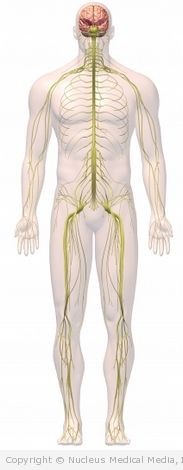Shy-Drager Syndrome
(Multiple System Atrophy-A, Multiple System Atrophy With Postural Hypotension; Striatonigral Degeneration)
Shy-Drager syndrome – Definition
Shy-Drager syndrome is a degenerative disorder of the nervous system. It is a type of multiple system atrophy which means more than one area of the nervous system can be affected.
Shy-Drager affects nerves that control involuntary bodily functions, such as blood pressure, bowel and bladder functions, and nerves that control movement. Shy-Drager syndrome may also cause a drop in blood pressure after changing position that can result in dizziness or fainting.
Shy-Drager syndrome – Causes
Shy-Drager syndrome is caused by degeneration or loss of nerves. It is unknown what causes the damage or loss of these nerves.
Shy-Drager syndrome – Risk Factors
Risk factors for Shy-Drager syndrome include:
- Age (being middle age or older)
- Male gender
Shy-Drager syndrome – Symptoms
Symptoms associated with the involuntary nerves usually occur first. Motor problems similar to those found with Parkinson’s disease may develop later. The variety of symptoms may include:
- Dizziness or fainting when standing or sitting up, or changing positions
- Dizziness may be worse in the morning or after meals
- Fatigue after physical exertion
- Muscle weakness
- Neck ache, which may radiate to the shoulders
- Constipation or diarrhea
- Erectile dysfunction in men
- Loss of sex drive
- Inability to control bowels or bladder ( incontinence)
- Urinary frequency and urgency that may be especially bothersome at night (occurs early in the disease)
- Gasping or noisy breathing
- Short stops in breathing during sleep ( sleep apnea)
- Impaired temperature control
- Reduced sweating
- Dry skin
- Vision problems
- Abnormal eye movements
- Slurred, faint speech
- Trouble swallowing
- Poor balance
- Unsteady walking
- Tremors
- Stiffness
- Slow movements
- Loss of facial expression
- Dementia (occurs late in the disease)
Shy-Drager syndrome – Diagnosis
Your doctor will ask about your symptoms and medical history. A physical exam will be done.
This disease is often hard to diagnose. There is no specific test for Shy-Drager syndrome, but testing helps rule out other conditions. Tests may include:
- Blood tests — to measure electrolytes and other blood chemistries.
- MRI scan — a test that uses magnetic waves to make pictures of the inside of the body.
- Electromyogram (EMG) — a test that measures and records the electrical activity of the muscles at rest and when contracted. It can check for muscle irritation and damage.
- Tilt-table test — measures changes in blood pressure as your body position changes
- Sleep studies — to check for disorders such as sleep apnea.
- Barium swallow — a series of x-rays of the upper digestive tract taken after you swallow a barium substance, which will show up on x-ray. In people with Shy-Drager syndrome, this test is used to assess swallowing problems.
Shy-Drager syndrome – Treatment
No cure exists for Shy-Drager syndrome. Some therapy may help you control symptoms including managing blood pressure problems.
Treatment may include:
Medication
Certain medication may be recommended depending on your symptoms:
- Drugs to prevent drops in blood pressure, including:
- Fludrocortisone (Florinef)
- Indomethacin (Indocid)
- Midodrine (ProAmatine)
- Beta blockers such as:
- Propranolol (Inderal)
- Pindolol (Sectral)
These medicines are used when changes in posture cause very rapid heart rate.
- Laxatives or stool softeners to treat constipation
- Drugs to treat urinary symptoms, including oxybutynin, tolterodine, or propantheline (may worsen constipation)
- Drugs to treat impotence, such as yohimbine or sildenafil—Sildenafil must be used with care as it can worsen the low blood pressure that occurs with the disease, causing dizziness and fainting.
Diet
Diet changes that may help control symptoms include:
- Increase salt and fluid to help keep blood pressure up when standing.
- Drink beverages containing caffeine after meals.
- Eat small, frequent meals.
- Eat soft foods, which may be easier to swallow.
- Increase fiber to help with constipation. Avoid straining when going to the bathroom.
- Avoid drinking alcoholic beverages.
Lifestyle Changes
Lifestyle modifications include:
- Exercise only moderately. Avoid vigorous exercise.
- Sleep with the head of your bed raised to help prevent drops in blood pressure when arising.
- Get up slowly and change positions slowly.
- Wear elastic support stockings and abdominal binders or a body suit to help maintain blood pressure.
- Avoid too much heat in your home (including when bathing) or environment.
To help you manage specific symptoms and side effects:
- Try speech therapy for help dealing with swallowing and speech problems.
- Work with an occupational therapist to help you with daily activities.
- If swallowing is a problem, ask your doctor about tube feedings.
- Join a support group for patients and/or family members.
- Ask your doctor about a penile implant and other treatments for impotence.
- Ask your doctor about intermittent catheterization for urinary problems.
- Ask your doctor before taking any drugs. Many patients with Shy-Drager syndrome are very susceptible to drug side effects even at low doses.
Breathing Support
If you have severe breathing problems that cannot be relieved in other ways, your doctor may advise that you have a tracheostomy. This is a surgically-created hole in the windpipe. It is usually done as a treatment of last resort.
Shy-Drager syndrome – Prevention
There are no guidelines for preventing Shy-Drager syndrome because the cause is unknown.

